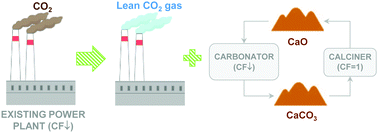Calcium looping CO2 capture system for back-up power plants
Abstract
This paper analyses a CO2 capture system based on calcium looping, designed for power plants that operate with very low capacity factors and large load fluctuations, including shut-down and start-up periods. This can be achieved by decoupling the operation of the carbonator and calciner reactors and connecting them to piles filled with CaO or CaCO3. When the power plant enters into operation, calcined solids are fed into the carbonator to provide the necessary flow of CaO for capturing CO2 and storing the carbonated solids. An oxy-CFB calciner designed to have a modest thermal capacity and operate continuously refills the CaO pile. Mass and energy balances of the entire system, combined with state-of-the-art performance criteria for reactor design, have been solved to identify suitable operating windows. An analysis of the effect of the CaO reactivity of the material stored in the piles indicates that temperatures of around 500–600 °C in the carbonator are compatible with the storage of solids at low temperature (<250 °C). This, together with the low inherent cost of the material, allows large piles of stored material. Electricity costs between 0.13–0.15 $ per kWhe are possible for the system proposed in contrast to standard CaL systems where the cost would increase to above 0.19 $ per kWhe when forced to operate at low capacity. The proposed concept could be integrated into existing power plants operating as back-ups in renewable energy systems in preference to other CO2 capture technologies that are heavily penalized when forced to operate under low capacity factors.



 Please wait while we load your content...
Please wait while we load your content...